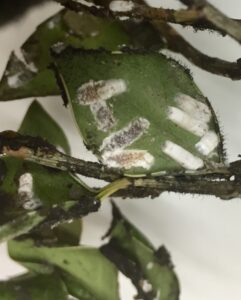Pest Alert – Scale Insects
go.ncsu.edu/readext?816798
en Español / em Português
El inglés es el idioma de control de esta página. En la medida en que haya algún conflicto entre la traducción al inglés y la traducción, el inglés prevalece.
Al hacer clic en el enlace de traducción se activa un servicio de traducción gratuito para convertir la página al español. Al igual que con cualquier traducción por Internet, la conversión no es sensible al contexto y puede que no traduzca el texto en su significado original. NC State Extension no garantiza la exactitud del texto traducido. Por favor, tenga en cuenta que algunas aplicaciones y/o servicios pueden no funcionar como se espera cuando se traducen.
Português
Inglês é o idioma de controle desta página. Na medida que haja algum conflito entre o texto original em Inglês e a tradução, o Inglês prevalece.
Ao clicar no link de tradução, um serviço gratuito de tradução será ativado para converter a página para o Português. Como em qualquer tradução pela internet, a conversão não é sensivel ao contexto e pode não ocorrer a tradução para o significado orginal. O serviço de Extensão da Carolina do Norte (NC State Extension) não garante a exatidão do texto traduzido. Por favor, observe que algumas funções ou serviços podem não funcionar como esperado após a tradução.
English
English is the controlling language of this page. To the extent there is any conflict between the English text and the translation, English controls.
Clicking on the translation link activates a free translation service to convert the page to Spanish. As with any Internet translation, the conversion is not context-sensitive and may not translate the text to its original meaning. NC State Extension does not guarantee the accuracy of the translated text. Please note that some applications and/or services may not function as expected when translated.
Collapse ▲What Are Scale Insects?
Scale insects are parasitic insects that use a hypodermic needle-like mouthpart to feed on the sugar-rich fluids inside plants. The insects are generally small. Some are so small that you need a microscope to see while others are the size of a pea.
Scales are related to aphids. The difference is that scales usually grow a covering of some sort while aphids are exposed to the elements and predators. Most scale insects secrete a waxy shell while other a sticky wax. Like aphids, scales produce sugary droppings that can coat plants. A fungus called sooty mold will grow on this sticky substrate and cover plants in a dark colored mold.
Plant Damage
Scale insects occur primarily on the undersides of leaves but can also live on bark and stems. Their piercing-sucking feeding kills individual plant cells. The most conspicuous characteristic of an infested plant is yellow splotching on the upper leaf surfaces. This is a symptom of feeding insects underneath leaves. Other symptoms include the whole plant appearing unhealthy decreased number of blooms and premature leaf drop.
Control
Control measures include keeping plants healthy. Scales insects occur in higher numbers on plants that are stressed due to environmental conditions or improper care. Gardeners should scout their plants regularly and cut out small infestations. Cut back heavily infested plants and destroy the clippings.

Some scales are very tiny and almost invisible to the naked eye. This is ‘obscure scale’ on a tree branch, very common on stressed urban trees.
Contact insecticides are aimed at the crawler stage prior to the nymphs secreting armor or waxy cotton. Spraying with insecticides in early spring helps to reduce the insect population. Horticulture oils during the dormant season or superior oils can be used after the leaves have hardened off in late spring. Systemic insecticides kill insects that feed on plant liquids. Although very effective on scale, systemic insecticides can affect insects that feed on flower nectar. As always, read the label of any insecticide before use. Contact your County Agent with any questions.
Reducing Pesticide Use
I advocate for reducing pesticide use whenever possible. My suggestion would be only use a pesticide when you have a pest problem as a curative. Using pesticides preventatively increases the amount of pesticides that we put into the environment unnecessarily. To reduce pesticide use we can monitor our plants for pests and treating when the problem is small before it becomes a big problem. The best thing we can do is to keep our plants healthy by fertilizing, watering and pruning properly.











